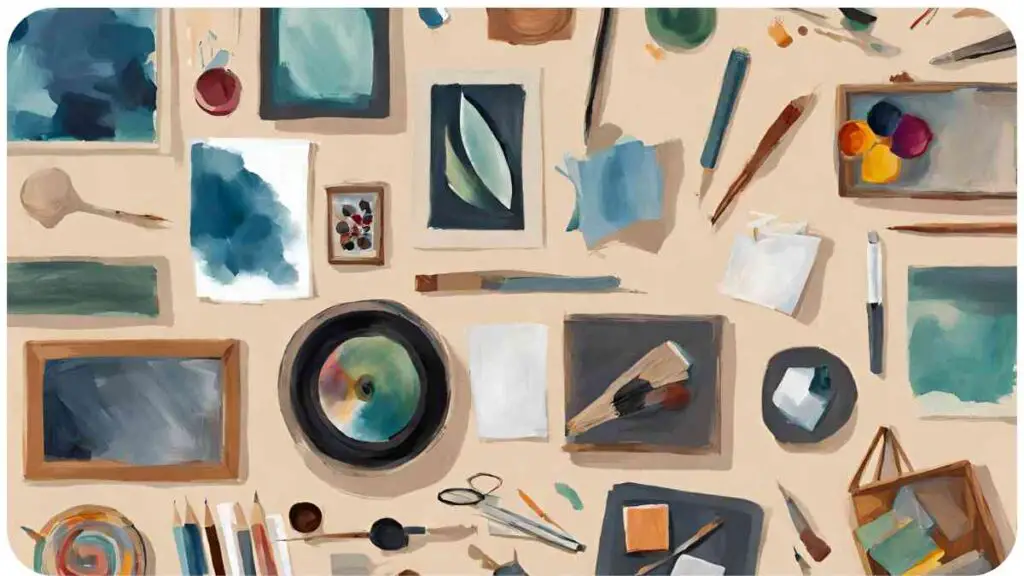Many artists dream of turning their passion for art into a profitable business. However, making that leap can be daunting.
With the right mindset, skills, and strategies, you can turn your art hobby into a thriving business that not only fulfills your creative aspirations but also generates income.
| Takeaways |
|---|
| Assess your skills and passions to identify your artistic niche. |
| Set clear goals and objectives to guide your entrepreneurial journey. |
| Create a comprehensive business plan to outline your strategies and financial projections. |
| Build a strong brand identity to differentiate yourself in the competitive art market. |
| Utilize online platforms and social media to showcase and sell your artwork. |
| Price your artwork competitively while considering factors like materials, time, and market demand. |
| Stay informed about legal considerations such as copyrights, contracts, and business licenses. |
| Implement effective marketing strategies to increase visibility and attract customers. |
| Network and collaborate with fellow artists and industry professionals to expand your opportunities. |
| Stay resilient and adaptable in the face of challenges, and continuously strive to improve your craft and business acumen. |
2. Assessing Your Skills and Passion

Before diving into the business side of things, take some time to assess your skills, strengths, and passions. Understanding what you excel at and what you love to create will help you determine your artistic direction and niche market.
When embarking on a scrapbooking journey, selecting the right materials is crucial for successful projects. With a myriad of options available, understanding your preferences and needs ensures every page tells a unique story.
Table: Personal Assessment Checklist
| Skills | Strengths | Passions |
|---|---|---|
| Drawing | Color theory | Landscapes |
| Painting | Composition | Portraits |
| Sculpting | Perspective | Abstract art |
| Digital art | Mixed media | Still life |
3. Identifying Your Niche
Identifying your niche is crucial for standing out in the competitive art market. Consider what sets your artwork apart and who your target audience is. Finding your niche will help you tailor your marketing efforts and attract the right customers.
Table: Popular Art Niches
| Niche | Description |
|---|---|
| Landscape | Scenic outdoor views and natural landscapes |
| Portraiture | Depictions of people, pets, or characters |
| Abstract | Non-representational or conceptual art |
| Street art | Urban art displayed in public spaces |
4. Setting Goals and Objectives
To succeed in the art business, it’s essential to set clear goals and objectives. Whether you aim to supplement your income, establish a full-time career, or gain recognition in the art world, having specific goals will keep you focused and motivated.
Transform your memories into timeless treasures through the art of DIY scrapbooking. Crafting personalized albums and journals not only preserves moments but also offers a therapeutic escape into creativity, allowing your personality to shine through every page.
5. Creating a Business Plan

A well-thought-out business plan serves as a roadmap for your art business. It outlines your goals, target market, competition, marketing strategies, and financial projections. Take the time to research and create a comprehensive business plan to guide your entrepreneurial journey.
Table: Components of a Business Plan
| Section | Description |
|---|---|
| Executive Summary | Overview of your business and its objectives |
| Market Analysis | Analysis of the art market and target audience |
| Marketing Strategy | Plan for promoting and selling your artwork |
| Financial Projections | Revenue forecasts and budgeting |
| Operations Plan | Details of how your business will operate |
6. Establishing Your Brand
Building a strong brand identity is essential for attracting customers and establishing credibility in the art world. Your brand should reflect your artistic style, values, and unique selling proposition. Invest time in creating a compelling brand image that resonates with your target audience.
Preserving memories goes beyond mere photo albums; it’s an art form. Learn the essentials of scrapbooking to immortalize your cherished moments elegantly. From layout designs to archival techniques, discover how to craft visually captivating narratives that stand the test of time.
7. Building an Online Presence
In today’s digital age, having a strong online presence is critical for reaching a wider audience and driving sales. Consider creating a professional website and leveraging social media platforms to showcase your artwork, engage with followers, and promote your brand.
Table: Social Media Platforms Comparison
| Platform | Pros | Cons |
|---|---|---|
| Visual platform ideal for showcasing artwork | High competition; algorithm changes | |
| Large user base; targeted advertising options | Declining organic reach; saturated market | |
| Visual search engine; long-term exposure | Slow initial growth; niche audience | |
| Real-time engagement; networking opportunities | Limited visual content; fast-paced platform |
8. Pricing Your Artwork
Determining the right pricing strategy for your artwork can be challenging. Consider factors such as materials, time invested, market demand, and perceived value. Research pricing trends in your niche and adjust your prices accordingly to ensure competitiveness and profitability.
9. Selling Your Art
Explore various sales channels to reach potential buyers and diversify your revenue streams. Whether you sell your artwork online, at galleries, art fairs, or through commissions, choose channels that align with your target market and business goals.
Elevate your woodworking craft with insider insights and expert tips to unlock professional secrets. Whether you’re a novice or seasoned artisan, mastering these techniques ensures precision, efficiency, and a refined finish in every project you undertake.
Table: Pros and Cons of Different Sales Channels
| Sales Channel | Pros | Cons |
|---|---|---|
| Online | Wide reach; low overhead costs | High competition; shipping logistics |
| Galleries | Prestige; curated exhibitions | High commission fees; limited control |
| Art Fairs | Direct interaction with buyers; networking | Booth fees; seasonal availability |
| Commissions | Customized artwork; steady income | Time-consuming; limited scalability |
10. Managing Finances
Effective financial management is crucial for the long-term success of your art business. Keep track of your expenses, income, and cash flow to ensure financial stability. Consider investing in accounting software or hiring a professional to manage your finances.
Table: Budgeting for Art Business
| Expense | Description | Monthly Cost |
|---|---|---|
| Art supplies | Materials for creating artwork | $200 – $500 |
| Website hosting | Hosting fees for your professional website | $10 – $50 |
| Marketing | Advertising and promotion expenses | $100 – $300 |
| Studio rent | Rental fees for your workspace | $500 – $1000 |
| Insurance | Liability and asset protection | $50 – $200 |
11. Legal Considerations
Navigating the legal aspects of running an art business is essential for protecting your work and avoiding potential legal issues. Consider trademarks, copyrights, contracts, and business licenses to ensure compliance and safeguard your artistic rights.
Table: Legal Structures for Art Businesses
| Legal Structure | Description | Pros | Cons |
|---|---|---|---|
| Sole Proprietorship | Individual ownership; simple setup | Full control; minimal paperwork | Unlimited personal liability |
| LLC (Limited Liability Company) | Limited liability protection; flexible management | Asset protection; tax advantages | Compliance requirements |
| Corporation | Separate legal entity; limited liability protection | Credibility; potential tax benefits | Complex setup and maintenance |
| Partnership | Shared ownership; shared profits and liabilities | Shared workload; diverse skillsets | Unlimited liability for partners |
12. Marketing and Promotion

Effective marketing strategies are essential for attracting customers and driving sales. Utilize a mix of online and offline marketing tactics such as social media marketing, email campaigns, collaborations, and art exhibitions to increase visibility and reach your target audience.
13. Networking and Collaboration
Networking with fellow artists, collectors, and industry professionals can open up opportunities for collaboration, mentorship, and exposure. Attend art events, join artist communities, and participate in group exhibitions to expand your network and grow your business.
14. Handling Challenges
Running an art business comes with its fair share of challenges, from creative blocks to financial uncertainties. Stay resilient and adaptable, seek support from peers and mentors, and continuously strive to improve your craft and business acumen.
15. Conclusion
Turning your art hobby into a business requires dedication, passion, and perseverance. By following the strategies outlined in this guide and staying true to your artistic vision, you can build a successful and fulfilling career as an artist entrepreneur. Embrace challenges as opportunities for growth, and never stop creating and innovating. Best of luck on your entrepreneurial journey!
Further Reading
Here are some additional resources to help you further explore the topic of turning your art hobby into a business:
- Matt Tommey Mentoring: Explore insights and advice from renowned artist and mentor Matt Tommey on how to transform your art hobby into a successful business venture.
- Udemy Course: Turn Hobby into Business: Enroll in this Udemy course to learn practical strategies and actionable tips for transitioning your hobby into a profitable business.
- FasterCapital: Selling Your Art: Discover valuable insights on choosing the right sales channels and platforms for selling your artwork, from the experts at FasterCapital.
FAQs
How do I determine my niche in the art market?
Identifying your niche involves assessing your artistic style, strengths, and passions. Consider what sets your artwork apart and who your target audience is. Researching market trends and competition can also help you find a niche that aligns with your skills and interests.
What are some effective online platforms for selling artwork?
Popular online platforms for selling artwork include Etsy, Shopify, and ArtStation. These platforms offer a wide reach and provide tools for showcasing and promoting your artwork to a global audience.
How should I price my artwork?
Pricing artwork involves considering factors such as materials, time invested, market demand, and perceived value. Researching pricing trends in your niche and assessing the uniqueness of your artwork can help you determine competitive and profitable pricing strategies.
What legal considerations should I be aware of when starting an art business?
Legal considerations for art businesses include copyright protection, contracts, business licenses, and tax obligations. Consulting with legal professionals specializing in intellectual property and business law can help ensure compliance and protect your artistic rights.
How can I effectively market my art business?
Effective marketing strategies for art businesses include utilizing social media, email marketing, collaborations, and participating in art exhibitions. Building a strong brand identity, engaging with your audience, and showcasing your artwork’s unique selling points can help attract customers and drive sales.

Hellen James is the creator of Unified Crafts and has been crafting since she was a kid accompanied by her mom to the craft store, where she was free to choose whatever ignited her imagination.

